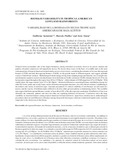Mostrar el registro sencillo del ítem
Biomass variability in tropical American lowland rainforests
| dc.rights.license | http://creativecommons.org/licenses/by-nc-sa/3.0/ve/ | |
| dc.contributor.author | Sarmiento, Guillermo | es_VE |
| dc.contributor.author | Pinillos, Marcela | es_VE |
| dc.contributor.author | Garay, Irene | es_VE |
| dc.date | 2005-11-16 | es_VE |
| dc.date.accessioned | 2005-11-16T09:00:00Z | |
| dc.date.available | 2005-11-16T09:00:00Z | |
| dc.date.created | 2005-01-01 | es_VE |
| dc.date.issued | 2005-11-16T09:00:00Z | es_VE |
| dc.identifier.issn | 1012-1692 | es_VE |
| dc.identifier.other | T016900000012/1 | es_VE |
| dc.identifier.uri | http://www.saber.ula.ve/handle/123456789/25579 | |
| dc.description.abstract | Tropical forest accumulates one of the largest biomasses among terrestrial ecosystems, however its precise amount and patterns of spatial variation are still imperfectly known. We discuss these issues on the basis of available data on the most widespread type of tropical American lowland rainforest (terra firme forest), considering the estimates of live tree aboveground biomass (LTAB) and total aboveground biomass (TAGB), in old-growth stands in different regions, and suggest probable sources of their broad variation. Methodological shortcomings arising from sampling design and intensity, size of sample unit,and allometric equations used to calculate biomass from field data are firstly considered. TAGB estimates based on 0.25 to one hectare plots ranged throughout the region from 160 to 435 Mg ha-1, while estimates of LTAB range from 167 to 419 Mg ha-1. With smaller plots, the range extends from 115 to 864 Mg ha-1. Structural differences concerning biomass distribution among two other life-forms: palms and woody lianas, and its allocation among plant structures, also show broad variation, contributing to the richness and variety of rainforest types. Amounts and patterns of vertical variability of root biomass are still much less known, and the scarcity of field data makes difficult to disclose either general patterns or determining factors. The available data suggest that belowground biomass reaches at least about 20% of the aboveground counterpart. Distribution of fine roots illustrates the contrasted patterns and show how they are exploiting different soil horizons. Conclusions stress the large variability in structural features among tropical American lowland rainforests. Apart from variation due to methodological procedures, there are real differences in biomass among old-growth forest types, which are evident at all spatial scales, from the single plot to the whole area of this biome. | |
| dc.format.extent | 119357 | es_VE |
| dc.language.iso | es | es_VE |
| dc.publisher | SABER ULA | es_VE |
| dc.rights | info:eu-repo/semantics/openAccess | |
| dc.subject | Biomasa aérea | es_VE |
| dc.subject | Biomasa arbórea | es_VE |
| dc.subject | Amazonia | es_VE |
| dc.subject | Estructura del bosque | es_VE |
| dc.subject | Biomasa radical | es_VE |
| dc.subject | Amazonia | es_VE |
| dc.subject | Forest structure | es_VE |
| dc.subject | Aboveground biomass | es_VE |
| dc.subject | Tree biomass | es_VE |
| dc.subject | Root biomass | es_VE |
| dc.title | Biomass variability in tropical American lowland rainforests | es_VE |
| dc.title.alternative | Variabilidad de la biomasa en selvas tropicales americanas de baja altitud | es_VE |
| dc.type | info:eu-repo/semantics/article | |
| dc.description.abstract1 | Las selvas de baja altitud presentan una de las mayores biomasas entre los ecosistemas continentales, sin embargo la cantidad precisa y sus escalas y patrones de variación espacial permanecen aun imperfectamente conocidos. Discutimos estos puntos en base a los datos disponibles para bosques maduros en América tropical (bosques de terra firme), considerando tanto estimados de biomasa aérea de árboles vivos (LTAB) como de biomasa aérea total (TAGB), así como algunos datos de biomasa subterránea en diferentes regiones. En primer lugar tomamos en cuenta las limitaciones metodológicas que surgen del diseño y la intensidad de muestreo, del tamaño de la unidad de muestreo, y de las ecuaciones alométricas que se utilizan para calcular la biomasa a partir de los datos de campo. Los estimados conocidos indican que la LTAB en parcelas de 0,25 a una hectárea cubren un rango de 167 a 419 Mg ha-1, los de TAGBde 160 a 435 Mg ha-1, mientrasque con parcelas menores los valores extremos son 115 y 864 Mg ha-1. La contribución a la biomasa aérea de palmas y lianas, también muestra grandes diferencias entre sitios.Igualmente, la representación de árboles pequeños, medianos y grandes en el total de la biomasa aérea, difiere ampliamente a lo largo de estas selvas. La distribución de la biomasa aérea entre diferentes estructuras contribuye asimismo a la riqueza y variedad de estos ecosistemas. Las cantidades y los patrones de variación vertical de la biomasa radical son aun menos conocidos, de modo que con los pocos datos disponibles se dificulta incluso señalar tendencias generales. Estos datos indican que la biomasa subterránea alcanza alrededor del 20% de la biomasa aérea. Las conclusiones enfatizan la gran variabilidad en características estructurales de las selvas americanas. Aparte de la variación debida a diferentes procedimientos metodológicos,existe una variación real en biomasa entre selvas maduras, evidente a diferentes escalas espaciales, desde la parcela hasta el conjunto del bioma. Se destaca la idea de que la variación es parte esencial de la estructura del sistema y que precisamente a través del análisis de la misma se podrán conocer mejor los determinantes ecológicos y la dinámica de las selvas tropicales. | |
| dc.description.colacion | 1-20 | es_VE |
| dc.description.email | sguille@ula.ve | es_VE |
| dc.description.email | mpgpapers@hotmail.com | es_VE |
| dc.description.frecuencia | semestral | es_VE |
| dc.description.tiponivel | Referencia analítica-- | es_VE |
| dc.identifier.depositolegal | 198802ME173 | es_VE |
| dc.subject.tipo | Revistas | es_VE |
Ficheros en el ítem
Este ítem aparece en la(s) siguiente(s) colección(ones)
-
Articulos, Pre-prints (Instituto de Ciencias Ambientales y Ecológicas (ICAE))
Articulos, Pre-prints del Instituto de Ciencias Ambientales y Ecológicas (ICAE) -
Ecotropicos - 018(1)
enero - junio 2005



